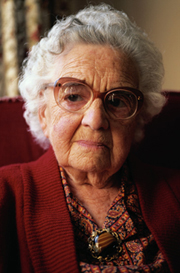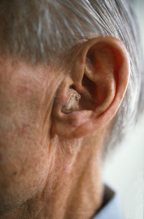

Patient-Related Factors
Physical impairments and cognitive limitations may increase the risk for nonadherence in older adults.
 Today in the United States there are approximately 5.5 million persons aged 65 and older who are blind or visually impaired (American Foundation for the Blind). Vision impairment is associated with a decreased ability to perform activities of daily living and an increased risk for depression (Rovner et al., 1996; Rovner and Ganguli, 1998). There are many medication safety issues associated with vision loss. Low vision and blindness affect a person's ability to read prescription labels and information sheets about medications, determine the color and markings distinguishing a medication, and see gauges on testing devices. People who cannot read prescription labels or distinguish among different medications must rely on memory or depend on someone else for help, and may not take their medications correctly or at all.
Today in the United States there are approximately 5.5 million persons aged 65 and older who are blind or visually impaired (American Foundation for the Blind). Vision impairment is associated with a decreased ability to perform activities of daily living and an increased risk for depression (Rovner et al., 1996; Rovner and Ganguli, 1998). There are many medication safety issues associated with vision loss. Low vision and blindness affect a person's ability to read prescription labels and information sheets about medications, determine the color and markings distinguishing a medication, and see gauges on testing devices. People who cannot read prescription labels or distinguish among different medications must rely on memory or depend on someone else for help, and may not take their medications correctly or at all.
Not all vision loss is the same and the issues differ depending on the nature of the visual impairment. For example, the needs of people with glaucoma who have tunnel vision are different from those with macular degeneration who have central vision loss. Also, individuals who are blind have different issues from individuals with low vision. Individuals who are blind may need audible devices, tactile devices, or Braille.
The National Institutes of Health has a health-related web site specifically for older adults, which can be found at www.nihseniorhealth.gov. The web site’s senior-friendly features include large print, short, easy-to-read segments of information, and simple navigation. A "talking" function reads the text aloud and special buttons to enlarge the text or turn on high contrast make the text more readable.
The American Foundation for the Blind's web site (www.afb.org) provides information about living with vision loss for the consumer, friends and family, and professionals. It contains an online directory of services and resources available in the US and Canada for persons with visual impairments. Additional resources for information on eye disease, low vision, and vision rehabilitation are available at the National Eye Institute website, www.nei.nih.gov/health/.
| BARRIER | STRATEGIES |
|
Blindness
|
Ask the person if he or she needs help and what would be useful
Do not talk down to or patronize the person
Do not direct communication to companion
Give clear verbal instructions
Tape record instructions
Provide instructions in Braille (if patient reads Braille)
Review pill shape/size with person
Use different size pill containers for different medications
Attach tactile "clue" to pill containers to differentiate among medications
Use pill organizer
Audible reminder (alarm) system
Pre-measure liquid dosages
Pre-cut tablets
Pre-fill syringes
|
|
Visual impairment
|
Ask the person if he or she needs help and what would be useful
Use large print on labels and written materials (minimum 16 point)
Use black ink on light background (high contrast) for written materials
Avoid materials that reflect light or cause glare
Provide large print duplicate prescription label
Give clear verbal instructions
Use color coding on medication containers (if patient can detect color) or different color pillboxes to distinguish between medications and indicate when to take medications
Electronic dispensing devices with an alarm when dose is due
Magnifying device
Encourage improved lighting where medications are stored and taken
|
 The number of people with hearing loss increases with age. One-third of older adults between the ages of 65 and 74 have hearing problems; about half the people who are 85 and older have hearing loss (National Institute on Aging). The natural aging process affects not only the ability to detect sounds at soft levels (hearing thresholds) but also the ability to understand speech at typical conversational volume. This condition is progressive and does get worse with age (Cienkowski, 2003).
The number of people with hearing loss increases with age. One-third of older adults between the ages of 65 and 74 have hearing problems; about half the people who are 85 and older have hearing loss (National Institute on Aging). The natural aging process affects not only the ability to detect sounds at soft levels (hearing thresholds) but also the ability to understand speech at typical conversational volume. This condition is progressive and does get worse with age (Cienkowski, 2003).
Many people who suffer from age-related hearing impairment report that they hear speech but have difficulty understanding, particularly in the presence of background noise. In environments with lots of noise or echo (reverberation), older adults identify fewer words correctly than younger adults with equivalent hearing (Cienkowski, 2003).
Most deaf people communicate with hearing people through a combination of methods such as signing, writing, speech, and lip reading. Always determine the person's preferred method of communicating. Some deaf people consider English their second language, after American Sign Language. It is important to note that American Sign Language does not follow the order and syntax of written and spoken English, therefore always ask if the person is comfortable with written language when you are using this mode of communication (University of Washington, 2005).
Do not assume that when deaf or hearing-impaired people nod their heads in acknowledgment that they have understood you; they may be relying on family or a companion present to explain later.
A growing number of government agencies and businesses are installing TTY or using the Telecommunications Relay Service to communicate with deaf, hard of hearing, or speech-impaired clients. A TTY is a special device that lets people who are deaf, hard of hearing, or speech-impaired use the telephone to communicate by allowing them to type messages back and forth to other TTY users. TTY consists of a keyboard, display screen, and a modem. Calls placed to or from a non-TTY user can be placed through the Telecommunications Relay Service. A directory of toll-free telecommunications relay service numbers can be found at www.adcohearing.com/tty_what_tty.html.
| BARRIER | STRATEGIES |
|
Deafness
|
Do not shout or exaggerate speech, garble words, or obscure mouth with hands
Do not talk down to or patronize the person
If American Sign Language is the person's preferred communication method:
If lip reading is the person's preferred communication method:
If writing is the person's preferred communication:
Face the person
Use gestures
Confirm understanding of information
Supplement with written information
Use pictures and diagrams when possible
|
|
Hearing impairment
|
Do not shout or exaggerate speech, garble words, or obscure mouth with hands
Do not talk down to or patronize the person
Use quiet area for counseling
Have assistive listening device available to be used if necessary
Stand in good lighting and reduce background noises
Face the person and talk slowly and clearly; use lower voice pitch and simple language
Include the hearing-impaired person when talking; talk with the person, not about the person, when with others
Be patient
Use facial expressions or gestures to give useful clues
Speak to better ear
Have person turn up hearing aid
Repeat yourself if necessary, using different words; confirm understanding of information
Supplement with written information
Use pictures and diagrams when possible
|
Impaired cognition is associated with poor medication adherence (Krueger et al., 2005). Older adults with cognitive decline or memory problems may have difficulty understanding how to take their medications, forget to take a dose, or take too much.
| BARRIER | STRATEGIES |
|
Cognition/memory
|
Speak slowly and clearly; use simple language
Repeat and rephrase information
Confirm understanding; have person repeat information
Provide written document using simple language to support verbal instructions
Introduce reminder strategies tailored to the individual, such as pill organizers, calendars, phone reminder systems, electronic medication dispensing devices
Involve caregiver
|
Older adults with limited mobility may have difficulty obtaining medications from the pharmacy or self-administering medications (Tobias, 2003).
| BARRIER | STRATEGIES |
|
Impaired mobility
|
Mail order pharmacy
Pharmacy delivery service
Store medications in easy-to-access location (unless children in household)
|
Impaired dexterity, coupled with reduced muscle strength and flexibility, affects fine motor control and hand-eye coordination. These functional limitations can affect the ability to open product packages or medication containers, administer nonoral dosage forms (e.g., injections, patches, inhalers, eye drops), use medical supplies or devices, or manipulate home testing equipment (e.g., glucose monitoring).
| BARRIER | STRATEGIES |
|
Impaired dexterity
|
Use easy-to-open, non-childproof medication containers
Use pill organizer
Use easy-to-open unit-of-use packaging
Pre-measure liquid dosages
Pre-cut tablets
Pre-fill syringes
Use dosage forms that are easy to administer
|
Older adults with swallowing problems may be unable or unwilling to take large pills or capsules.
| BARRIER | STRATEGIES |
|
Swallowing problems
|
Identify alternative dosage forms that might be easier to swallow, e.g., liquids, smaller tablets, transdermal products
Switch to medications that can be crushed or capsules that can be opened and mixed with soft foods
|

